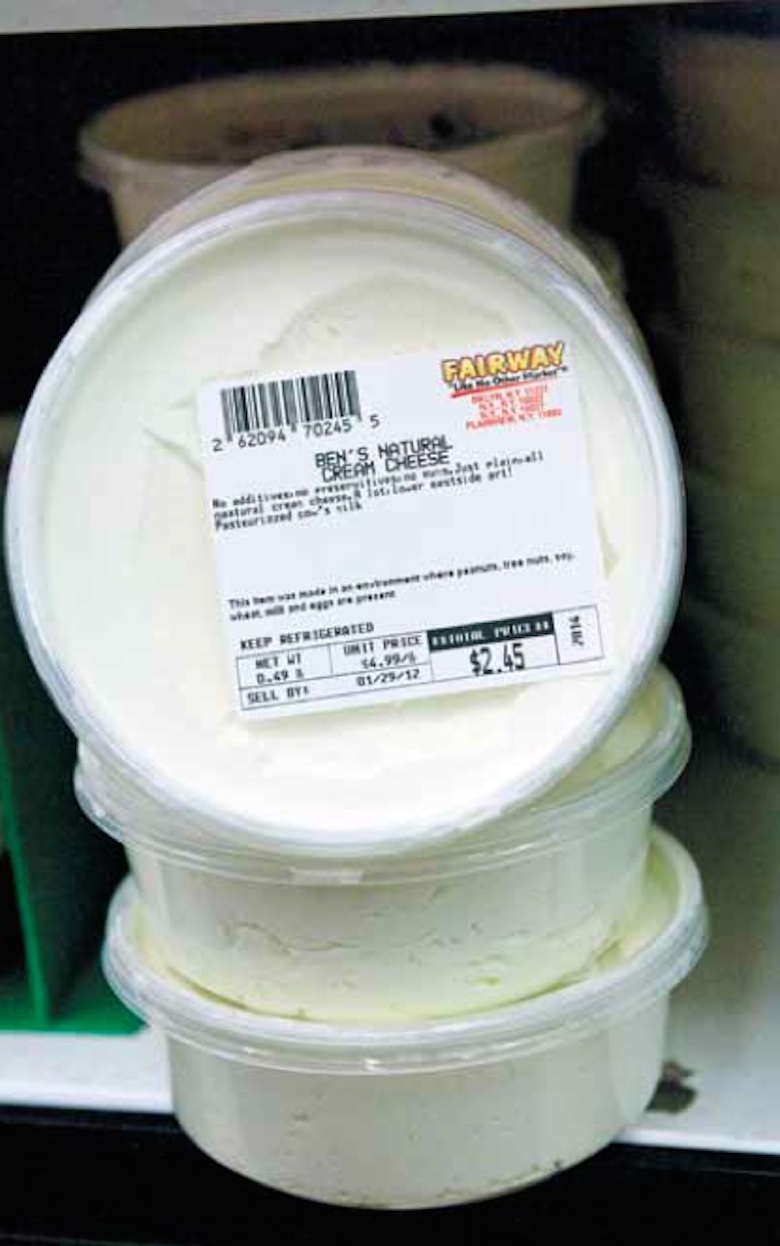
For decades it’s been stocked at best-in-class food shops like Dean & DeLuca and Murray’s, but other than a store’s own sloganeering (“Unlike any other cream cheese you’ve ever had!” boasts Fairway), you won’t find much on the package besides a bar code. Happy cow graphics and sweet company story? Fuggedaboutit.
Googling doesn’t do any good either: In an era when everything for sale has its own Twitter feed, search for Ben’s and you’ll find little more than a skeletal Web site and various Chowhound.com posts asking in vain if anyone knows anything more about it—other than how amazing it tastes.
Heck even Steve Jenkins—the long-standing cheese and specialty food buyer for Fairway —can’t tell you how it’s made, and he’s been buying from Jonah Friedman, Ben’s owner, since 1977. “I know as much or as little as I know about how he makes it as I did 35 years ago, because Jonah’s so secretive,” says Jenkins, author of The Cheese Primer, a 1996 tome on great cheeses still found on every monger shelf. “We have an agreement,” Jenkins explains, “it’s sort of ‘don’t ask don’t tell.’ As long as he keeps delivering buckets of that remarkable product, I won’t ask him any questions.”
If, after much sleuthing, you somehow get Friedman on the phone—the first time I reached him, he had to excuse himself to get farmers’ cheese out of the oven—the conversation still leaves much to the imagination. How much cream cheese does he make?
“Thousands of pounds, it varies by season.” Where does he buy his ingredients? “Local farms, upstate.” Ask him how it’s made, and he changes the subject, answering your question with his own: “How do you keep a bagel from being stolen?” Friedman jokes: “Put lox on it.”
But if you patiently peel back the layers of history—more delicate than the foil encasing a brick of Philadelphia—you will learn that, in the beginning, one Ben Gorodinsky created Ben’s Cheese Planet, as he called it, around 1960, at the precise epicenter of Jewish deliciousness: 181 Houston Street, where neighbors included Russ & Daughters, Yonah nishery and the original Moishe’s Bake Shop.
In 1971 Friedman bought the business from Gorodinsky (in fact his original co-owner was Moishe, though Friedman eventually bought him out). From 1971 until Friedman closed its retail counter in 2000, it was a holy golden era of culinary kibbitzing, when Jewish families ventured in from distant lands and outer boroughs if not for holy manna, for a decent bagel.
And so it was here that Trillin, Jenkins and so many other whitefish worshipers fell under the spell of that one sublime schmear.
For seven more blissful years, Friedman continued making his cream cheese, farmer’s cheese, tofu, pot cheese, hoop cheese and even butter in the back at 181 Houston, selling it wholesale to people like Jenkins, and renting out the space up front. But then, like so many old customers before him, he packed up in 2007 and ascended to less expensive space in the promised land of Rockland County.
In the early days, Jenkins used to walk to the Lower East Side from the flagship Dean & DeLuca in SoHo, where he was helping Joel Dean and Giorgio DeLuca source specialty products from companies around the world. But while most of those have modernized, Friedman still delivers his ethereal cream cheese in buckets and writes the price on the plastic pail in pencil. At Fairway and everywhere else, they have to pack the stuff into their own tubs for resale. “We scrape every bucket to the bottom,” insists Jenkins.
Why go to all the trouble, when other brands are plenty tasty and come in easy-to-stack packages? “It’s the only one with that texture,” gushes Jenkins, “none of that waxy stuff.” He’s mainly talking about gums and additives—added by everyone from Philadelphia to those making organic versions. Cream cheese—which was actually invented in the late 1800s in upstate New York, yet another holy land for Orthodox Jews—is made from cream-enriched whole milk, making it higher fat than most other fresh cheeses. Once coagulated and strained into cheese, the fat starts to repel the water—so most manufacturers use guar or carob gum to keep their products on shelves a little longer.
Some Manhattanites might now prefer the familiarity of those rectangular, foil-wrapped packs, but like Jenkins we’ll take Ben’s on our bagel any day. And yes, Jonah, you better believe we’re gonna put lox on it.
Ben’s Cream Cheese can be found at Fairway, Dean & DeLuca, Grace’s Marketplace,
Agata & Valentina, Balducci’s, Citarella, East Village Cheese or Murray’s;
for not very much more information, go to BensCheesePlanet.com
Philly? Fuggedaboutit.
Cream cheese is similar to mascarpone—also a fresh cheese made from a mix of milk and cream—but its origins lie in Petit Suisse, a soft, sweet little round with 30 percent fat, created in the 1850s at a Normandy dairy by a Swiss employee, who had the delicious idea to use cream to enrich the curd that became their cheese. The product we know was actually first made by William Lawrence in an Orange County town called Chester, in 1862. The American cheesemaker, of course, added more fat: Cream cheese must now be at least 33 percent fat according to the USDA. The product was eventually christened Philadelphia cream cheese, since at the time, that city was considered to be the best for its fancy food; Kraft bought the brand in 1928.



